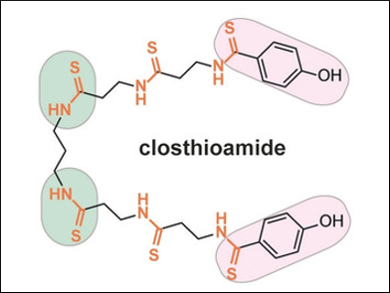Closthioamide (CTA, pictured) is a polythioamide-containing antibiotic produced by the Gram‐positive soil bacterium Ruminiclostridium cellulolyticum. CTA is a promising drug candidate with potent activity against important pathogens. It is one of only a handful of thioamidated natural products and the only one known that is a nonribosomal peptide. This means it is synthesized by peptide synthetases instead of the ribosome, the cell’s “factory” for protein synthesis. CTA’s exact biosynthetic pathway has remained elusive so far.
Christian Hertweck and colleagues, Leibniz Institute for Natural Product Research and Infection Biology, Jena, Germany, have identified the gene cluster responsible for CTA biosynthesis. Based on the structure of CTA, the team predicted which enzymatic transformations could be needed for its formation. A bioinformatic analysis was then used to hone in on a region of the R. cellulolyticum genome which encodes enzymes that are expected to have those activities. When this genome region was mutated by genome editing, the CTA production was lost, which validated the assignment.
The researchers suggest a model for CTA biosynthesis that proceeds through a thiotemplate mechanism. This is a mechanism for the synthesis of peptides in which the amino acid residues are transferred one-by-one to the thiol groups of a peptide synthetase. This synthetase collects the amino acids in sequence and finally, the synthesized peptide is cleaved off. The results pave the way for studying and understanding the full CTA biosynthetic pathway, according to the researchers.
- Genome Editing Reveals Novel Thiotemplated Assembly of Polythioamide Antibiotics in Anaerobic Bacteria,
Kyle Dunbar, Hannah Büttner, Evelyn Molloy, Maria Dell, Jana Kumpfmueller, Christian Hertweck,
Angew. Chem. Int. Ed. 2018.
https://doi.org/10.1002/anie.201807970




